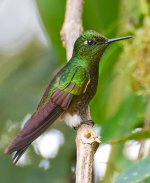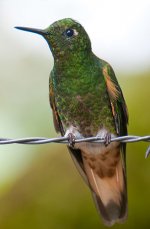Ecuadorrebel
Writer, Photographer, Guide
I originally thought that this was a Buff-Tailed Coronet but after looking at it again I can't justify the puff legs. Same with the Rufus-Tailed Hummingbird. I am open for suggestions. I don't see any Pufflegs with this color in the tail and I don't see any other hummers that have this color with the pufflegs.
thanks
Steve
thanks
Steve






